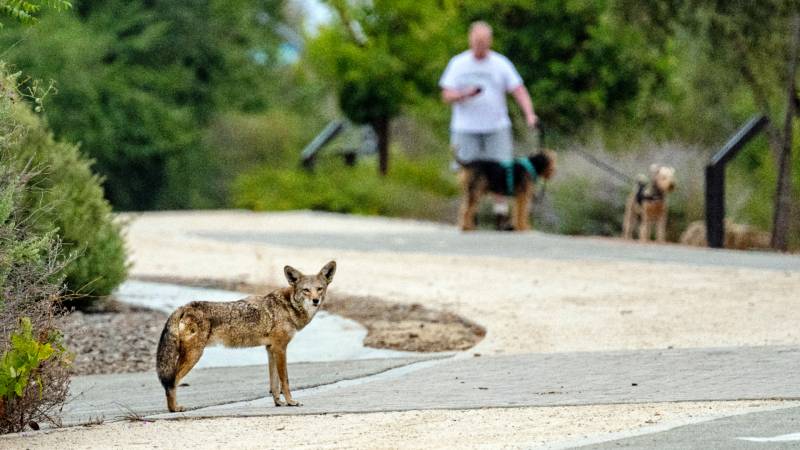Native to California, coyotes are common in urban green spaces up and down the state. Once eradicated from San Francisco, they’ve made a comeback in the city, with sightings on the rise and reports of pet attacks, including an incident involving a 5-year-old child. We’ll talk about best practices to keep you and your pets safe and learn about the essential role coyotes play in California’s ecosystem. Have you had a recent encounter with a coyote?
Coexisting with California’s Urban Coyotes

Guests:
Tali Caspi, urban ecologist, PhD Candidate at UC Davis
Christopher J Schell, Assistant Professor, Department of Environmental Science, Policy and Management at UC Berkeley
Christine Wilkinson, conservation scientist, carnivore ecologist, research associate at California Academy of Sciences - manages www.bayareacoyote.org
Show Highlights
Understanding Reports of Conflict with Coyotes
Christine Wilkinson, a conservation scientist and carnivore ecologist, explains that measuring conflict with urban coyotes is challenging because the available data only captures reported incidents, not routine sightings where no conflict occurred. “Out of all of the reports that we have that people have said, ‘Hey, I saw a coyote here or there,’ these were conflicts. And if people aren’t reporting their sightings that are sort of run of the mill ordinary interactions that don’t result in any sort of conflict, then it’s difficult for us in San Francisco and anywhere else to tell you whether conflicts are increasing.”
Christopher Schell, an assistant professor at UC Berkeley, acknowledges that more sightings may stem from increased human activity in green spaces during the COVID-19 lockdowns, allowing people to observe coyotes they may have previously missed. However, he suggests this does not necessarily equate to more conflicts: “There [was] certainly an uptick in the number of sightings of coyotes, [but] not necessarily an increase in the number of conflicts.”
Coyote Behavior and Habituation
Tali Caspi, an urban ecologist at UC Davis, dispels the notion that coyotes move into cities due to food scarcity or habitat loss. Instead, she explains, “They are one of the species whose range has actually expanded with urbanization” because humans have created a habitat with plenty of food resources available to them.
Christine Wilkinson says that coyote behavior can be misinterpreted as conflict, such as when they “escort” humans away from dens in the spring, which observers may perceive as stalking or chasing. She stresses the importance of educating communities about natural versus concerning behaviors to promote coexistence.
When coyotes lose their fear of humans through food conditioning or habituation, that can mean more conflict. Intentional feeding and access to fallen fruit or garbage in particular can reinforce positive associations with humans, potentially leading to bolder behavior.
Personal Experiences and Concerns
Several callers shared personal experiences and concerns regarding coyote encounters. Tamara from San Francisco recounted being attacked by a coyote along with her dogs at the Palace of Fine Arts. Hadley from Berkeley described a frightening incident where a coyote lunged at him and his wife and their cat while they were seated near their front door.
Martha from San Francisco, the chair of the Crissy Field Dog Group, reported over a hundred instances of coyote attacks on dogs in the Crissy Field, Baker Beach, and Presidio areas since April 2022, resulting in seven dog deaths. She expressed frustration at the lack of data sharing from the Presidio Trust and emphasized the need for better coyote management strategies.
Other callers and comments highlighted the trauma experienced by pet owners whose animals were attacked or killed by coyotes, as well as concerns about coyotes approaching children or residential areas.
Coexistence Strategies and Deterrents
The experts emphasize promoting coexistence strategies rather than lethal population control methods, which are ineffective for coyotes due to their ability to rebound rapidly from such culling.
Hazing techniques, such as making loud noises and appearing large and intimidating until coyotes retreat, are recommended for deterring unwanted close encounters. Tali Caspi also mentions specialized vests with spikes that some dog owners use to deter predation attempts on small pets.
Coyote roller bars on fences can help protect yards in some instances. But the experts recommend an overarching focus on fostering a “culture of coexistence” through community education, responsible waste management to avoid attractants, adhering to signage about pupping areas and finding fulfillment in connecting with nature through means other than feeding wildlife.
Coyotes’ Ecological Role in Cities
The experts stress that cities should be viewed as interconnected with nature, not separate from it. Christopher Schell highlights coyotes’ role as “de facto apex predators” in maintaining biodiversity and controlling rodent populations that can spread zoonotic diseases. Their presence enables a broader variety of species to thrive through these “top-down processes.”
Schell says that coyotes serve as “ecosystem service agents” whose presence should be embraced, as they represent the leading edge of human-wildlife interface that will only intensify with climate change. “Coyotes are the avatar of that conversation for us to reimagine and reshift the way in which we think about these cities…in community with nature,” he says.
This content was edited by the Forum production team but was generated with the help of AI.